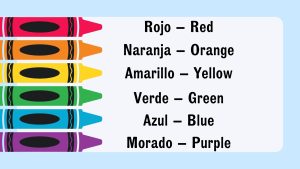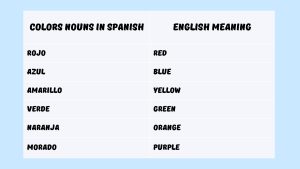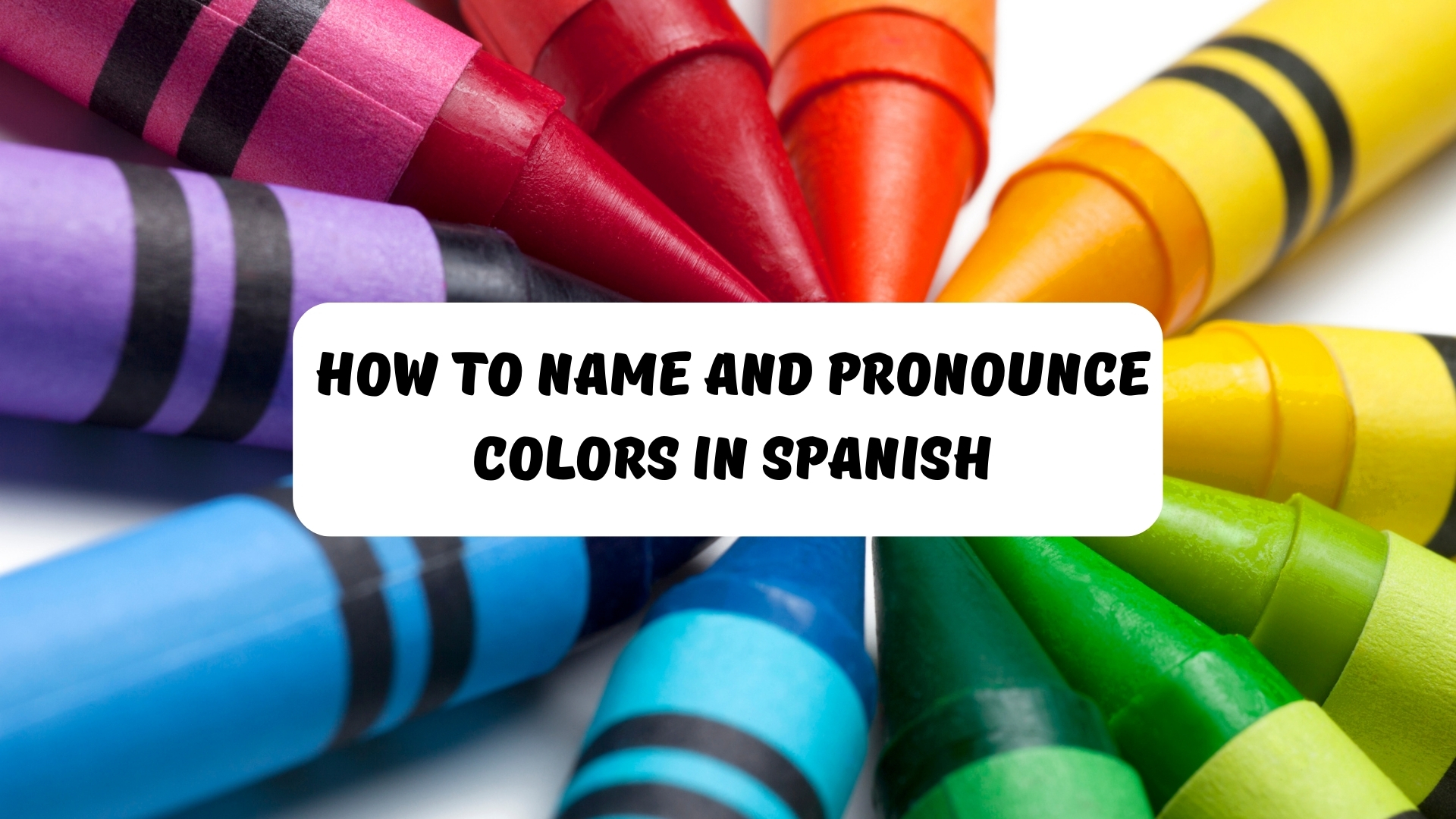When you learn how to name and pronounce colors in Spanish, you’re doing more than just memorizing words. You’re getting a chance to fine-tune your language skills. For example, knowing when to use ‘rojo’ for masculine items and ‘roja’ for feminine ones really matters. And remember, some words like ‘azul’ stay the same for both genders.
Also, adding words like ‘claro’ for light and ‘oscuro’ for dark before a color can change how people picture that color. Getting these details right can do more than just boost your vocabulary—it can give you a deeper understanding of how colors weave into the Spanish culture.
Basic Colors In Spanish
When learning basic colors in Spanish, remember to include light and dark shades. Understanding these details helps you communicate more accurately.

Plus, knowing these variations connects you deeper with the culture in Spanish-speaking places.
| Color in Spanish | Meaning |
|---|---|
| Rojo | Red |
| Azul | Blue |
| Verde | Green |
| Amarillo | Yellow |
| Negro | Black |
| Blanco | White |
| Gris | Gray |
| Marrón | Brown |
| Naranja | Orange |
| Rosa | Pink |
| Morado | Purple |
| Celeste | Light Blue |
| Violeta | Violet |
| Dorado | Gold |
| Plateado | Silver |
| Cian | Cyan |
| Magenta | Magenta |
| Turquesa | Turquoise |
| Índigo | Indigo |
| Lavanda | Lavender |
Other Colors in Spanish
Going beyond the basic red, blue, and yellow, several other colors are crucial in everyday Spanish. These include marrón for brown, rosa for pink, and violeta for purple.
Each color helps describe objects, settings, and feelings. They make everyday Spanish more vivid and expressive.
| Color in Spanish | Meaning |
|---|---|
| Ámbar | Amber |
| Caoba | Mahogany |
| Cobre | Copper |
| Esmeralda | Emerald |
| Granate | Garnet |
| Lila | Lilac |
| Malva | Mauve |
| Mostaza | Mustard |
| Perla | Pearl |
| Rubí | Ruby |
| Sienna | Sienna |
| Salmón | Salmon |
| Azabache | Jet Black |
| Cereza | Cherry Red |
| Carbón | Charcoal |
| Pizarra | Slate |
| Cobalto | Cobalt |
| Bronce | Bronze |
| Oliva | Olive |
| Coral | Coral |
Master the different ways to say and use “naranja” in Spanish!
Light and Dark Colors in Spanish
Using light and dark colors in Spanish really helps you express yourself better.
You can say ‘claro’ to mean light, like ‘azul claro’ for light blue, or ‘oscuro’ for dark, like ‘verde oscuro’ for dark green.
This makes your descriptions more vivid, whether you’re talking, writing a story, or painting.
It’s a simple way to make your Spanish more powerful.
| Phrase in Spanish | Meaning |
|---|---|
| Rojo claro | Light Red |
| Rojo oscuro | Dark Red |
| Azul claro | Light Blue |
| Azul oscuro | Dark Blue |
| Verde claro | Light Green |
| Verde oscuro | Dark Green |
| Amarillo claro | Light Yellow |
| Amarillo oscuro | Dark Yellow |
| Gris claro | Light Gray |
| Gris oscuro | Dark Gray |
| Marrón claro | Light Brown |
| Marrón oscuro | Dark Brown |
| Naranja claro | Light Orange |
| Naranja oscuro | Dark Orange |
| Lila claro | Light Lilac |
| Lila oscuro | Dark Lilac |
| Turquesa claro | Light Turquoise |
| Turquesa oscuro | Dark Turquoise |
| Rosa claro | Light Pink |
| Rosa oscuro | Dark Pink |
Spanish Colors That Change with Gender
In Spanish, some colors change depending on the gender of the noun they describe. For instance, ‘rojo’ turns into ‘roja’ if it’s describing something feminine.
This matching of gender is crucial for speaking and writing Spanish correctly. It makes sure everything sounds right and clear.
Table showing examples of colors changing gender
In Spanish, colors change to match the gender of the nouns they describe. For example, ‘rojo’ turns into ‘roja’ for feminine nouns.
On the other hand, ‘verde’ stays the same for both genders because of its ending.
It’s important to get these changes right to communicate clearly and to improve your Spanish.
| Masculine Form | Feminine Form | Meaning |
|---|---|---|
| Blanco | Blanca | White |
| Negro | Negra | Black |
| Rojo | Roja | Red |
| Amarillo | Amarilla | Yellow |
| Morado | Morada | Purple |
| Dorado | Dorada | Gold |
| Plateado | Plateada | Silver |
| Anaranjado | Anaranjada | Orange |
| Oscuro | Oscura | Dark |
| Claro | Clara | Light |
| Verde limón | Verde lima | Lime Green |
| Rosado | Rosada | Pinkish |
| Bordó | Bordó | Burgundy |
| Bronceado | Bronceada | Bronzed |
| Canela | Canela | Cinnamon |
| Cobrizo | Cobriza | Coppery |
| Cremoso | Cremosa | Creamy |
| Esmeraldino | Esmeraldina | Emerald Green |
| Plateado | Plateada | Silver |
| Turquesado | Turquesada | Deep Turquoise |
Spanish Colors That Don’t Change with Gender
Some Spanish color names stay the same, no matter if the noun they describe is masculine or feminine. For instance, ‘marrón’ means brown and ‘azul’ means blue, regardless of the noun.
This is handy for beginners since you don’t have to change these colors to match the gender of the nouns. It makes picking up some Spanish a bit easier.
| Color in Spanish | Meaning |
|---|---|
| Azul | Blue |
| Verde | Green |
| Marrón | Brown |
| Rosa | Pink |
| Beige | Beige |
| Lila | Lilac |
| Violeta | Violet |
| Turquesa | Turquoise |
| Caqui | Khaki |
| Ámbar | Amber |
| Mostaza | Mustard |
| Oliva | Olive |
| Fucsia | Fuchsia |
| Índigo | Indigo |
| Malva | Mauve |
| Bronce | Bronze |
| Rubí | Ruby |
| Cian | Cyan |
| Magenta | Magenta |
| Perla | Pearl |
The Grammar for Colors in Spanish
In Spanish, colors change depending on the nouns they describe. This is a key part of how the language works. If a noun is masculine and singular, the color word matches that. For example, a blue shirt is ‘camisa azul’ — ‘camisa’ is feminine but it uses the masculine color form because ‘azul’ doesn’t change with gender.
On the other hand, for plural and feminine nouns, like ‘casas rojas’ (red houses), the color word becomes feminine and plural too. This shows just how colors in Spanish can be flexible but also a bit complicated.
| Rule | Example in Spanish | Meaning |
|---|---|---|
| Colors are adjectives | El coche rojo | The red car |
| Adjectives match gender | La flor roja | The red flower |
| Adjectives match number | Los coches rojos | The red cars |
| Some colors never change | La camisa azul | The blue shirt |
| Light/Dark use “claro/oscuro” | Verde claro | Light green |
| Colors can be nouns | El azul del cielo | The blue of the sky |
| Colors after nouns | Un vestido amarillo | A yellow dress |
| “De color” + color | Un coche de color rojo | A car of red color |
| Nationality adjectives behave similarly | Una bandera francesa | A French flag |
| Some colors are compound | Azul turquesa | Turquoise blue |
| Adding “-ado” for texture | Amarillento | Yellowish |
| Changing meaning with context | Negro de rabia | Black with rage |
| Some colors describe moods | Estar verde | To be inexperienced |
| Colors describe temperature | Azul frío | Cold blue |
| Colors describe sound | Voz dorada | Golden voice |
| “Color” is singular | Me gusta el color rojo | I like the color red |
| No article with colors | Prefiero azul | I prefer blue |
| Colors used for metaphors | Un negocio negro | A shady business |
| Some colors come from nature | Color arena | Sand-colored |
| Some color words come from objects | Marrón chocolate | Chocolate brown |
Color adjectives in Spanish
In Spanish, using colors isn’t just about knowing the words; they can be adjectives or nouns. When they’re adjectives, colors need to match the gender and number of the nouns they describe. This matching is key to making your sentences sound right and make sense.
| Adjective | Example | Meaning |
|---|---|---|
| Brillante | Azul brillante | Bright blue |
| Oscuro | Verde oscuro | Dark green |
| Claro | Amarillo claro | Light yellow |
| Apagado | Rojo apagado | Dull red |
| Intenso | Naranja intenso | Intense orange |
| Vivo | Azul vivo | Vivid blue |
| Pastel | Rosa pastel | Pastel pink |
| Neutro | Marrón neutro | Neutral brown |
| Fluorescente | Verde fluorescente | Fluorescent green |
| Satinado | Blanco satinado | Satin white |
| Mate | Gris mate | Matte gray |
| Llamativo | Fucsia llamativo | Striking fuchsia |
| Suave | Lila suave | Soft lilac |
| Pálido | Amarillo pálido | Pale yellow |
| Radiante | Dorado radiante | Radiant gold |
| Opaco | Azul opaco | Dull blue |
| Cristalino | Azul cristalino | Crystal-clear blue |
| Plateado | Gris plateado | Silvery gray |
| Reluciente | Oro reluciente | Shiny gold |
| Turbio | Marrón turbio | Murky brown |
Colors Nouns in Spanish
Color adjectives in Spanish can actually turn into nouns when we’re talking about the color on its own.

For instance, ‘el rojo’ translates to ‘the red one.’ When used as nouns, these color words must match the gender and number of the nouns they describe. This means they can change to be plural or feminine, depending on the situation.
| Color as Noun | Example | Meaning |
|---|---|---|
| El azul | Me gusta el azul del mar | I like the blue of the sea |
| El rojo | El rojo de sus labios | The red of her lips |
| El negro | El negro de la noche | The black of the night |
| El verde | El verde del bosque | The green of the forest |
| El amarillo | El amarillo del sol | The yellow of the sun |
| El blanco | El blanco de la nieve | The white of the snow |
| El marrón | El marrón del café | The brown of the coffee |
| El naranja | El naranja del atardecer | The orange of the sunset |
| El gris | El gris del humo | The gray of the smoke |
| El violeta | El violeta de las flores | The violet of the flowers |
| El dorado | El dorado del oro | The gold of the gold |
| El plateado | El plateado de la luna | The silver of the moon |
| El rosa | Me encanta el rosa suave | I love soft pink |
| El turquesa | El turquesa del océano | The turquoise of the ocean |
| El índigo | El índigo de la tinta | The indigo of the ink |
| El mostaza | Me gusta el mostaza cálido | I like warm mustard |
| El esmeralda | Su vestido es de un esmeralda vibrante | Her dress is a vibrant emerald |
| El cobre | El cobre de la estatua | The copper of the statue |
| El lila | El lila del campo de lavanda | The lilac of the lavender field |
| El perla | El perla de su collar | The pearl of her necklace |
Learn when to use the preterite vs. imperfect in Spanish!
Use colors when you speak Spanish
When you use colors in your Spanish conversations, your descriptions become clearer and more engaging.
It’s important to get the details right, like matching the gender and number of colors with the nouns they describe.
Practice this in your daily chats. It makes a big difference in how well you communicate in Spanish.
| Phrase | Meaning |
|---|---|
| “Tengo un coche azul.” | I have a blue car. |
| “Compré una chaqueta roja.” | I bought a red jacket. |
| “El cielo es celeste hoy.” | The sky is light blue today. |
| “La manzana es verde.” | The apple is green. |
| “Ella tiene el pelo negro.” | She has black hair. |
| “Mi color favorito es el morado.” | My favorite color is purple. |
| “Las paredes son amarillas.” | The walls are yellow. |
| “El agua parece turquesa.” | The water looks turquoise. |
| “Este suéter es marrón oscuro.” | This sweater is dark brown. |
| “El vestido es blanco y negro.” | The dress is black and white. |
| “Me gusta el verde lima.” | I like lime green. |
| “Las flores son de color lavanda.” | The flowers are lavender-colored. |
| “Tus zapatos son fucsia brillante.” | Your shoes are bright fuchsia. |
| “Me gustan las camisetas de color pastel.” | I like pastel-colored t-shirts. |
| “La camiseta es de un azul marino intenso.” | The t-shirt is an intense navy blue. |
| “La pintura de la casa es mostaza apagado.” | The house paint is dull mustard. |
| “El reloj tiene detalles en oro brillante.” | The watch has bright gold details. |
| “El coche es de un gris mate elegante.” | The car is an elegant matte gray. |
| “Prefiero un sofá de un color neutro.” | I prefer a neutral-colored sofa. |
| “Las cortinas son de un azul pálido.” | The curtains are a pale blue. |
Conclusion
Mastering colors in Spanish really boosts your language skills. Knowing the basic colors, their different shades, and how they change with gender helps a lot.
It’s also important to get the grammar right when you’re using colors. This makes sure you’re understood clearly.
Being good at describing things with colors not only makes your Spanish richer but also smoother in daily chats and when you need to describe something well.
Master a new language from the comfort of your home – Lingua Viva!
Born in Cali, but raised in London, Juan Pablo has led an interesting life. He has an undergraduate degree in Foreign Language and 10+ years of experience. Juan Pablo has taught and worked as a professor and interpreter in Spanish, English, and French languages. He prides himself on having a ‘situational teaching style’, which means he caters lessons to fit student needs. He is serious about teaching, responsible, professional, clear, and concise.











